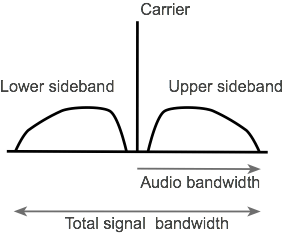Amplitude Modulation in Amateur Radio
Amplitude Modulation, AM, was the first type of transmission used to carry sound and it is still occasionally used in amateur radio today
Amateur Radio Voice Modes Includes:
Ham radio voice modes
Amplitude modulation
Frequency modulation
Single sideband
Digital voice summary
D-STAR
M17 digital voice
Amplitude modulation was the first form of modulation used to carry sound and in particular voice communication over radio.
Although it is nowhere near as efficient as other forms of modulation, it can very occasionally be heard on the amateur radio bands today.
In amateur radio circles the abbreviation, AM, is sometimes jokingly used to stand for Ancient Mode.
Amplitude modulation technology
The concept behind amplitude modulation is very straightforward, the audio or other modulating signal is used to vary the amplitude of the carrier or RF signal.

The main drawback of amplitude modulation is the very low efficiency. The carrier is there purely as a reference for demodulation and does not contribute to the transfer of information, resulting in a large wastage of power. Also the fact that the two sidebands are mirror images of each other means that overall signal uses twice as much spectrum as is really needed.

Note on Amplitude Modulation:
Amplitude modulation, AM is a form of modulation that uses a fixed frequency carrier wave which then has the amplitude or intensity of the signal modulated in line with the waveform of the modulating (audio) signal.
Read more about Amplitude Modulation, AM.
Decline in use of AM for amateur radio
The use of AM within amateur radio was relatively widespread in the early to mid 1960s on the HF bands as single sideband transceivers were still something of a novelty. As SSB became the mode of preference for ham radio operation on the HF bands, the use of AM declined in the late 1960s and early 1970s. It was sometimes used for local contacts on 160 metres and sometimes 80 metres.
One of the issues that was that when the bands were busy with amateur radio stations being received from many areas of the globe, the carriers would cause heterodynes that could make copy very difficult. With single sideband today, interference is still an issue, but the heterodynes caused by the AM carriers could give rise to much higher levels of interference, especially as notch filters were not common on receivers.
On the amateur radio VHF bands, AM was the operating mode of choice in the early and mid 1960s. As frequency modulation, FM because more popular as a result of its superior performance for mobile and portable applications, the use of AM declined. Now it is hardly ever heard on the amateur radio VHF and UHF bands.
Current amateur radio AM applications
Although the use of amplitude modulation is very low these days, there are some areas where it is used.
One of the main areas of amateur radio amplitude modulation use is on the Ten Metre band. Often old converted CB transceivers may be used, or others just wanting to use amplitude modulation to communicate with others..
There are no specific frequencies that are allocated for AM use on Ten Metres, but AM contacts should take place between 29.0 and 29.1 MHz or in some cases up to 29.2 MHz.
Vintage AM ham radio equipment
In view of the times when AM was widely used for amateur radio transmissions, the equipment was almost exclusively valve or tube based. The equipment was large and heavy.
The equipment had to be capable of running the continuous power for the carrier, so a 150 watt transmitter would have to be able to support running that power level for many minutes without a break.
For the best audio, the anode of the final amplifier had to be modulated - again this mean high power levels. Often the audio amplifier would run in class B push pull and 75 watts of audio was required for a 150 watt AM transmitter if it was to have 100% modulation.
The power levels involved were high, for the signal developed and this was one reason why AM transmitters were large and heavy.
There was a large variety of what is now termed vintage AM amateur radio equipment. One of the more popular items was the Heathkit DX100U that was available in the USA and also in Europe. Its smaller cousin, DX40U had less power, the modulation system was not quite as good, and the basic transmitter was crystal controlled, but it was very much cheaper. There was a separate VFO which could be added and this made it much more flexible.
Other names from the past include the vintage Johnson Viking Valiant transmitter which could deliver around 100 watts of power and covered the HF bands. In the UK, KW Communications Ltd produced their KW Viceroy and KW Valiant transmitters.
Many other AM transmitters were available and many radio amateurs built their own equipment, some examples of which occupied a complete equipment rack.
Vintage ham radio equipment for amplitude modulation is available on various websites and there is a small, but enthusiastic band of people who enjoy using AM.
 Written by Ian Poole .
Written by Ian Poole .
Experienced electronics engineer and author.
More Ham Radio Topics:
What is ham radio
Callsigns
Morse code
Voice modes
Digital data modes
QRP operating
Operating awards
Codes & abbreviations
Ham bands overview
Operating via differnet propagation modes
Repeaters
Callsigns
Contact formats
Setting up a shack & buying equipment
Return to Ham radio menu . . .


